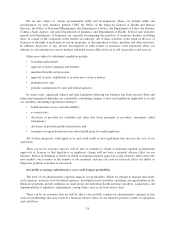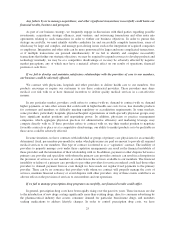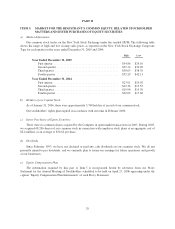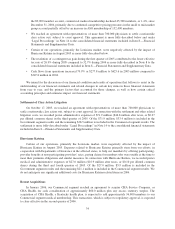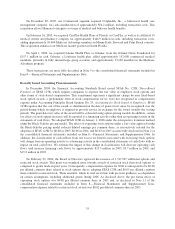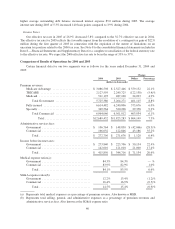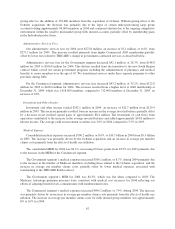Humana 2005 Annual Report Download - page 42
Download and view the complete annual report
Please find page 42 of the 2005 Humana annual report below. You can navigate through the pages in the report by either clicking on the pages listed below, or by using the keyword search tool below to find specific information within the annual report.and medical procedures, increasing capacity and supply of medical services, new prescription drugs and
therapies, an aging population, lifestyle challenges including obesity and smoking, the tort liability system, and
government regulations.
Government Segment
In our Government segment, the passage of the MMA in December 2003 demonstrated the federal
government’s commitment to providing health benefits and options to seniors by creating new product choices
for Medicare-eligible individuals sold through the private sector. These new products include PFFS plans and
local PPOs, with coverage effective in 2005, and regional PPOs and PDPs, with coverage effective in 2006. The
PFFS plans generally offer additional benefits compared to traditional Medicare in exchange for a monthly
premium paid by the member. These plans typically include a prescription drug benefit with no provider network
restrictions. Local and regional PPO plans typically offer an even higher level of benefits to members, including
a prescription drug benefit and a lower level of member cost-sharing on many benefits when the member uses
medical services from in-network providers.
As a long-time participant in the Medicare program, we believe that we possess (1) business competencies
and management experience with senior product design, (2) a robust and scalable multi-channel distribution
system, (3) an established and competitive network including a national retail pharmacy network, and (4) an
established brand awareness with seniors. Accordingly, we have developed a strategy to take full advantage of
these expanded programs. This resulted in significant expenditures and commitments of resources during 2005,
including, among other items:
• increasing the number of markets where we sell our products,
• designing products that offer a compelling combination of price and benefits to capture market share,
• raising brand awareness with the launching of our “Let’s Talk” education campaign, as well as
substantial marketing and advertising increases,
• expanding the distribution network, including partnering with Wal-Mart Stores, Inc. and increasing our
captive sales force,
• increasing the size and scope of our provider network, and
• adding employees to accommodate membership growth, including opening a dedicated Medicare
service center in Tampa Bay, Florida.
Our strategy and commitment to these expanded Medicare Advantage programs has led to substantial
growth during 2005. Medicare Advantage membership increased to 557,800 members at December 31, 2005, up
47.9% from 377,200 members at December 31, 2004, primarily due to sales of our new PFFS products and the
addition of 50,400 members from our acquisition of CarePlus Health Plans of Florida in February 2005.
Likewise, Medicare premium revenues have increased 48.7% to $4.6 billion for 2005 from $3.1 billion in 2004.
We expect the Medicare line of business to continue to grow during 2006 from continued geographic expansions
of our Medicare Advantage offerings and our new PDP plans. As of February 1, 2006, Medicare Advantage
membership totaled more than 700,000 members and PDP membership totaled approximately 1.7 million
members. We expect 2006 Medicare premium revenues to more than double from 2005 from sales of our
Medicare Advantage and PDP plans and for selling, general and administrative expenses to continue to increase
in 2006. However, while our creation of the infrastructure related to our Medicare expansion will be nearly
completed by the end of the first quarter of 2006, we do not believe the resulting expected revenues and
membership will peak until Medicare enrollment is completed on July 1, 2006. We believe this will result in
lower earnings and margins in the first half of 2006 relative to the second half of 2006, when we believe our
consolidated revenues will reach the level contemplated by our selling, general, and administrative expenses.
32




